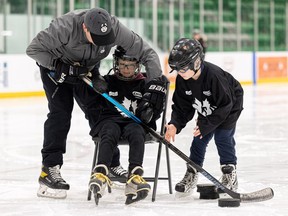"I love hockey, but I hadn't tried hockey."

Hasan Alhmada skated, and fell, all over Merlis Belsher Place on Tuesday.
The 12-year-old boy, who moved from Syria to Saskatoon in 2019 and is legally blind, looked increasingly comfortable during just his second time on ice.
“I’m not good on skates,” said Alhmada, perhaps a little modestly, given that he actually wasn’t all that bad despite his lack of experience. “The first time I tried it I kept falling, and I still fall, but I’m at least trying to balance.”
Alhmada was at Merlis Belsher as part of a clinic run by Canadian Blind Hockey. The event was designed to introduce the sport locally to youth aged four to 18, and the boy looked happy as his blades cut small grooves into the slick surface.
He noted that there was no real outlet for him to try a sport he’s developed a fondness for. That changed a few weeks ago, when he heard Canadian Blind Hockey was coming to town.
“I love hockey,” he said, “but I hadn’t tried hockey.”
Alhmada can detect light, and he can see people and objects when they’re very close to him. But he couldn’t see the outsized pucks, filled with noisy ball-bearings, that criss-crossed the arena during Tuesday’s event.
“He’s a new Canadian, but he’s just as Canadian as all the rest of us here today,” said Canadian Blind Hockey program manager Luca DeMontis, who spent some one-on-one time with Alhmada. “He’s having a blast, and he’s kept me on my toes. He’s got some great questions, and he’s definitely done his research coming into this program. He hasn’t stopped smiling since he walked into the arena today.”
Blind hockey is designed for players with vision ranging from 10 per cent to completely blind. The ball-bearing-filled puck, which is much larger than the traditional disc, is the biggest change — players can follow it by sound, rather than sight.
Another key adaptation happens once a team moves into the offensive zone. They must make one successful pass, after which the referee blows a high-pitched whistle, which lets opposing defenders and the goalie know a shot could be incoming.
“It’s so important to get them on the ice,” said DeMontis, who was aided Tuesday by members of the University of Saskatchewan Huskies men’s hockey team. “We’re Canada, and this is our nation’s game. It was so cool to see Canada win gold at the world juniors. Seeing these kids on the ice, they’re winning gold today.
“The one word I hear is ‘finally: Finally, I’m able to play this game. Finally, I can shoot a blind hockey puck.’ ”
Those in attendance included Joni Kokko, an exchange student at the University of Saskatchewan who is from Finland. He landed in Saskatoon on New Year’s Day, and Tuesday was his first time on skates since arriving.
Kokko first tried the sport three years ago, and it’s since become a big part of his life. He played at a large blind hockey tournament in Toronto last year and is planning a return, so he saw Tuesday’s get-together as a chance to limber up his hockey legs.
“I just love hockey,” he said. “There’s no better word for it. I love competing. This is my dream come true.
“Just like in Canada, Finland also, ice hockey is everything. Everyone loves it, everyone plays it or watches it. And because the visually impaired are not able to play with a small puck, having a chance to play with this big puck, it just feels so good.”
DeMontis noted Canada has 14 blind hockey programs, but none in Saskatoon. He hopes Tuesday’s gathering could be the start of something bigger here.
“Saskatchewan is a hockey province, and this is a hockey city,” he said. “You’ve got strong roots, and there should be no reason why Canadian Blind Hockey can’t also have a team here.
“The goal from today is to get these kids on the ice, let them feel like they’re part of a team, let them fall and get back up. That’s so symbolic for life. When you’re down and times are tough, you want to get right back up. A lot of kids have done that today.”

Post a Comment